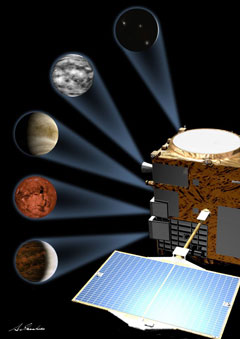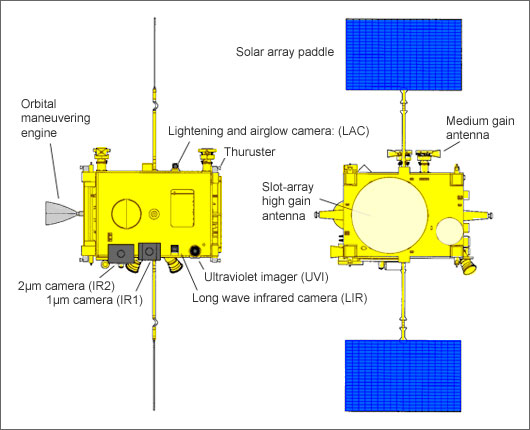AKASTUKI will elucidate the mysteries of Venus, Earth's twin sister.
Japan will initiate the beginning of a new era of Venusian exploration.
 AKATSUKI (PLANET-C) is the next planetary exploration project for the Martian orbiter NOZOMI. This project's main purpose is to elucidate the mysteries of the Venusian atmosphere. Though often referred to as Earth's sister planet in terms of size and mass, Venus is actually very different. It is veiled in carbon dioxide, with a high temperature and thick sulfuric-acid clouds. Clarification of the causes for this environment will provide us with clues to the understanding of the birth of Earth and of its climate changes. Therefore, Venus is a very important subject for exploration.
AKATSUKI (PLANET-C) is the next planetary exploration project for the Martian orbiter NOZOMI. This project's main purpose is to elucidate the mysteries of the Venusian atmosphere. Though often referred to as Earth's sister planet in terms of size and mass, Venus is actually very different. It is veiled in carbon dioxide, with a high temperature and thick sulfuric-acid clouds. Clarification of the causes for this environment will provide us with clues to the understanding of the birth of Earth and of its climate changes. Therefore, Venus is a very important subject for exploration. Infrared light enables more detailed investigation of Venus.
The probe vehicle of AKATSUKI will enter an elliptical orbit, 300 to 80,000 km away from Venus's surface. This wide variation in distance will enable comprehensive observations of the planet's meteorological phenomena and of its surface, as well as observations of the atmospheric particles escaping from Venus into space. It will also be possible to take close-up photos of Venus, and to observe the storm winds that blow on the Venusian surface, at speeds that reach 100 m a second - 60 times the speed at which Venus rotates. This phenomenon remains the biggest mystery of Venus, as it cannot be explained meteorologically. AKATSUKI will employ infrared light to observe and elucidate the mysteries surrounding the atmosphere under the clouds and the conditions on the planet's surface. In addition, it will confirm the presence of active volcanoes and thunder.Exploring the Venusian Atmosphere - PLANET-C Venus Climate Orbiter -
Major Characteristics of AKATSUKI
| Main Characteristics | |
| Shape and Size | Box shape with two wing-type solar array paddles (1.04 meters x 1.45 meters x 1.4 meters) |
| Scheduled Orbit | Type: Venus elliptical orbit PeriVenus: 300 km ApoVenus: about 80,000 km Orbital Period: 30 hours Orbital Inclination: 172 degrees |
| Scheduled Life | 4.5 years after liftoff |
| Mass | Mass at liftoff: about 500 kg |
| Power | Generated Power in Venus Orbit: about 500 W (at the end of the mission) |
| Mission Equipment for Scientific Observation |
Mission Equipment / Major Observation Target - 1μm camera (IR1) / Low stratus, vapor, active volcanism - 2μmcamera (IR2) / Low stratus, trace gasses, zodiacal light - Long wave infrared camera (LIR) / Cloud-top temperature distribution - Ultraviolet imager (UVI) / Cloud-top ultraviolet absorber, SO2 - Lightening and airglow camera: (LAC) / Lightening flash, high-stratus airglow emission - Ultra-stable Oscillator (USO) / Atmospheric temperature structure |
Configuration of the AKATSUKI

